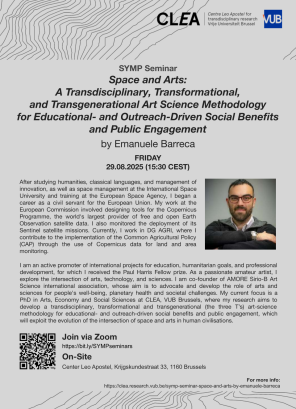About the seminar
Space and art are the long-lasting drivers of our evolution into culture-based societies, and heritage-based civilizations. Many myths refer to the empowerment given to space by ancient humans, which translated into beliefs, religions, ceremonies, architectural sites for cult, cults, and art. So, as the transdisciplinary outcome of the “art(s)pace binomial twin agent” manifests from the intersection between artistic and scientific quests, it is still strongly shaping our species’ evolutionary path, and its distinguished trait: ”experiencing solutions to complexity by different means (also driven by technology applications) and by transcending our perception and expanding it”. How? Thanks to the combined use of new knowledge about Earth, collected through space (satellites), and about space, as also seen from the human point of view on Earth for millennia. Experiential techniques, indeed, help in communicating effectively in the context of today’s need of setting up-to-date relationships in the societies, such as the ones between teachers and students, work environments and workers, policy makers and citizens, engaging youth. So, the educational connection between Earth and space “observations” can be tested for relevant pedagogical and awareness needs by using an art science methodology allowing switching to a knowledge transferring experience that is inclusive, multifaceted, and simultaneously “solo and group” oriented. Different modularizations of the methodology outcome depend on changing from one observation point to the other and the selection of the tools used for representing, embodying, and giving relevance to the observations. Therefore, this paper presents an analysis leading to a methodology whose goal is enhancing transdisciplinary and transformational educational activities and public engagement and contributing to reaching social benefits. How? By focusing on analyzing and categorizing the interrelations between different areas of knowledge, technologies, science, and arts while combining areas of artistic expression and experiences that can be catalyst elements. This fits into a current research stream willing to give feedback to high and local policy levels about the need to feed the institutional and corporate communication, teaching and learning systems with contemporary knowledge- and arts-based organizational forms. Understanding our societies’ impact on the planet, as well as our responsibility for our common natural and cultural heritage, might need an “all at once” multisensorial dimension, allowing both solo, sharing, participatory and intergenerational approaches. Examples of interdisciplinary areas where this educational and outreach methodology could be used are a) agriculture and the evolution of humanity; b) ecology and planetary boundaries; c) cultural heritage and multispecies perspective.
About the speaker
I studied humanities, classical languages and economics and management of innovation (EPFL) and space management (ISU - International Space University). Since 2009, after a traineeship at the European Space Agency (ESA), I work as a civil servant for the European Union institution. At the European Commission I could design the toolsets that led to the implementation of the “Copernicus programme”, today’s world largest provider of "free and open Earth Observation satellite data", and monitoring the deployment of its satellites, “the Sentinels” space mission. I am now an official in DG AGRI contributing to CAP innovation and implementation through Copernicus for EU Member States land parcels and area monitoring.
Holder of the Paul Harris Fellow prize of the Rotary International, I have been ever active in participating and promoting international projects for education, humanitarian goals, professional networks development and solidarity. I am a passionate amateur artist exploring through many arts his own personal development and his vision about the role and the power of interconnecting arts, technologies, and sciences (outer space and planet Earth). I am co-founder of AMORE Sirio-B Art Science international association, whose aim is to advocate and develop the role of arts and sciences for people's well-being, planetary health and societal challenges. Having become an expert in the field, I decided to explore and create opportunities allowing the paradigm-shift that the availability of such an amount of free data from space brings to citizens, politicians, organisations. So, now, in parallel with my work, I am a PhD candidate on Arts, Economy and Social Sciences at the CLEA department (VUB Brussels), where innovative research is developed under the light of “deep interdisciplinarity”, “integrating worldviews”, “Arts Science”, “the future information society”. The PhD research has the target to develop a transdisciplinary, transformational and transgenerational (“the three Ts”) art science methodology for educational- and outreach-driven social benefits and public engagement, which will exploit the evolution of the intersection of space and arts in human civilisations.
Practical
This seminar is taking place both on-site at the Center Leo Apostel, VUB Campus, and online via Zoom.
Watch the recording here.

